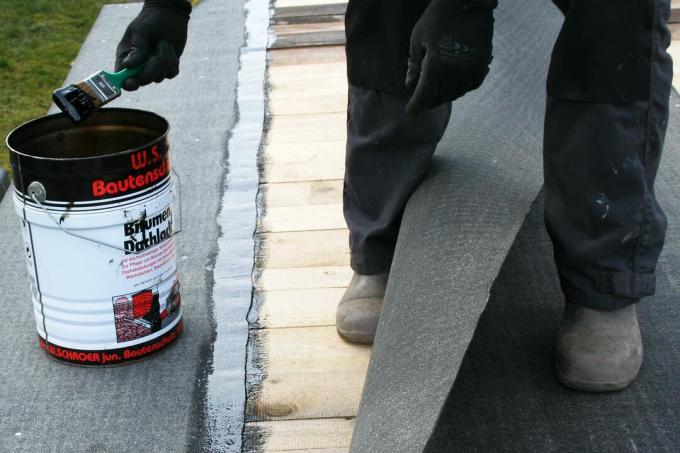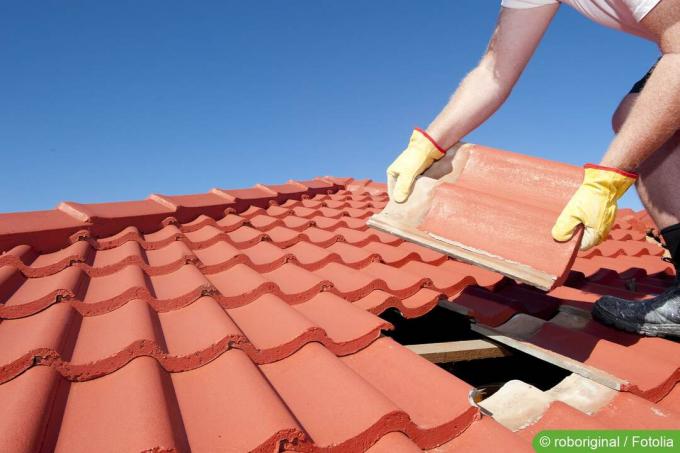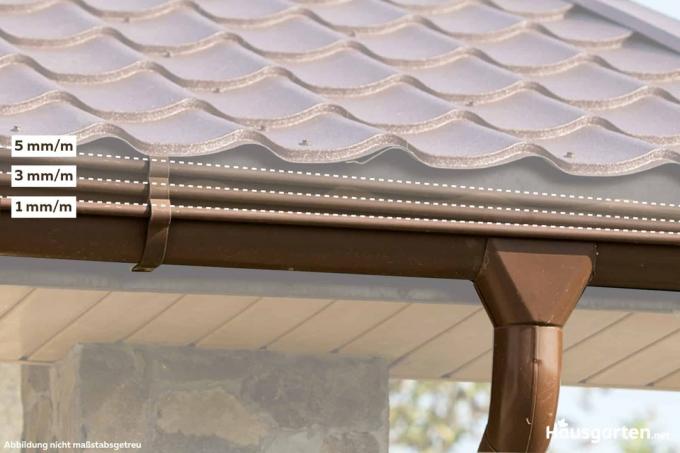

Table of contents
- bitumen and tar
- Bitumen stains on skin
- Bitumen stains on clothing
- Bitumen stains on car paint
- Pieces of bitumen on car wheels
- Remove stains from concrete yourself
- Get the concrete cleaned professionally
- dry ice blasting
- fine blasting
Have you discovered black, sticky stains on clothing, hands or the car? It is probably bitumen or tar. Don't despair! A simple home remedy offers its solvent power.
bitumen and tar
Black, sticky stains can be either tar or bitumen. It is true that tar is now classified as harmful to health and is no longer used. But we can still encounter it in everyday life. As a pavement on old roads or as an adhesive, waterproofing or in roofing felt in older houses, even indoors. Bitumen is a tar-like mass that can be obtained naturally or from petroleum. It is currently still in use. Visually, the two materials can hardly be distinguished. This is also not decisive for stain removal, because the procedure is congruent.
Tip:
If you suspect that there is tar in your four walls, you should definitely investigate. Because the fumes that it gives off to a large extent, especially when exposed to heat, are considered carcinogenic.
Bitumen stains on skin
Prevention is the best solution. Long-sleeved clothing and the use of gloves where practical will protect against stains. If tips do get to the skin, they must be removed as soon as possible. As long as the stains are still fresh, they can simply be washed off with water. Stains that have already dried are difficult to remove. But with the following fats you can also get rid of them:
- butter
- margarine
- cooking oil
One of these fats is thoroughly rubbed into the contaminated skin areas and then rinsed off with plenty of water. Stubborn residue can be made to disappear with the subsequent use of a brush and soap.
Tip:
Do not try to remove bitumen stains with conventional solvents such as acetone. They hardly have a cleaning effect on the black, sticky mass, but they irritate the skin.

Bitumen stains on clothing
Wearing old clothes is highly recommended when working with bituminous materials. Because bitumen splashes can hardly be avoided. In addition, there is no guarantee that they can be completely removed. Here, too, you have the best chance of pore-deep cleanliness with oil. The instructions in detail:
- Rub the stained area with oil as early as possible, because the older the stain, the more difficult it is to remove.
- Let the oil soak in for a bit.
- Then rinse the area with water.
- Then wash the laundry items normally in the washing machine.
There are some secret remedies shared on the internet that are also said to do a good job of getting rid of this type of stain. But before you reach for benzine, turpentine oil and the like, make sure that the fabric of your garment will survive contact with them undamaged.
Tip:
The additional use of gall soap can help to remove stain residues from the fabric even better. However, this tried and tested stain remover is not recommended for all types of fabric. Please note the information on the packaging of the gall soap.
Bitumen stains on car paint
Black spots on the car are rare. If so, they usually appear in summer. Then road surfaces can get very hot. The tar or bitumen components lose their solid, stable form. Under the pressure of tires, small, soft pieces can detach from the road surface and initially stick to the tires. Due to the turning movement of the wheels, they later reach other parts of the vehicle, where they remain thanks to their adhesive strength and dry out when the temperatures cool down. All car stains are removed with butter, margarine or cooking oil.
- first rub grease on the stain
- let soak for ten minutes
- then clean the area thoroughly with water and washing-up liquid
- only use a soft cloth for sensitive paintwork
- If there are stubborn residues, polish the paintwork with paint polish
Tip:
Only use pure fats. With greasy products, such as creams, there is a risk that the paint will be attacked by the other ingredients.

Pieces of bitumen on car wheels
Pieces of bitumen on tires are usually not noticeable because they do not differ in color and are also hidden in grooves. But the next heat is guaranteed to melt them. If the wheels then move while driving, renewed stains on the paintwork are inevitable. So, if you have discovered spots on the paintwork, you should also check the tires right away. Since they are made of robust material, you can also use a stable brush here. Passionate motorcyclists should also check their motorbike clothing for stains in summer.
Remove stains from concrete yourself
Wherever bitumen is used for construction and craft work, concrete is usually not far away. Bitumen spatter should be avoided as much as possible. Because the removal of these stains on your own is expensive. Depending on the location and number of stains, there are several methods available:
- Chemical removal: The chemical agent is applied to the stains. After the specified exposure time, the bitumen can be removed from the substrate with a spatula. Ideal for smaller areas.
- Mechanical/manual removal: The pieces of bitumen are removed from the surface with a hammer, chisel and lots of muscle power.
- Removal with heat: The bitumen layer is first heated with a gas burner. The softened material is then removed with a spatula.
Tip:
If the contaminated surface consists of natural stones, you should obtain a special cleaning agent for natural stones from a retailer. Other means may be too aggressive.
Get the concrete cleaned professionally
It is possible to hire a specialist company to remove the stain. This professional stain removal costs money. On the other hand, it saves your own time and effort and guarantees a professional approach. Two different methods are used:
dry ice blasting
- Dry ice (in pellet form) is "shot" at the stains with high pressure
- as a result, the temperature of the bitumen is suddenly greatly reduced
- the material shatters immediately and can be collected
- the concrete is protected because its dimensional stability is not changed
fine blasting
The blasting material used has sharp edges. When it hits the bitumen material, it is ground off layer by layer. The procedure is carried out until the last residue has been sanded off.
Tip:
Save yourself the tedious or Avoid expensive stain removal by completely covering any nearby concrete areas before beginning work.
 Home editorial office
Home editorial office
Learn more about roof / attic

Snow blows under roof tiles: what to do?
Snow drifts often get under the roof tiles when blizzards or strong winds blow them underneath. The moisture often causes damage from meltwater. Air spaces between the roof tiles are to blame. Homeowners should now find out how to counteract this.

Gutter slope: the ideal gradient
For a gutter to function properly, a slope that has an ideal inclination is required. Various factors have to be taken into account. Before installation, you should find out how the gradient is to be calculated and implemented.

Which attic insulation can be walked on immediately?
Attic insulation effectively reduces heat loss from the building. If the attic is to continue to be used as storage space, the insulation should be accessible as soon as possible. A number of materials can be used for this. They each have advantages and disadvantages as well as different costs.

Attic: OSB or Rauspund as roof boarding?
Both OSB and Rauspund boards are suitable as roof boarding. But what are the differences and what is better suited for the attic? Our guide answers these and other questions about the two materials.

Laying a vapor barrier: how far does the vapor barrier have to go?
Laying a vapor barrier is essential in some cases. But how far does the vapor barrier have to be installed, what is it and what are the differences? These and more questions are answered in the following guide.

Decision-making aid: 11 garden shed roof coverings
When it comes to the roof covering for the garden house, there are differences in terms of material, costs and effort. Our guide shows what you should pay attention to and where the respective advantages and disadvantages lie. This gives you a decision-making aid for the garden house roof.
